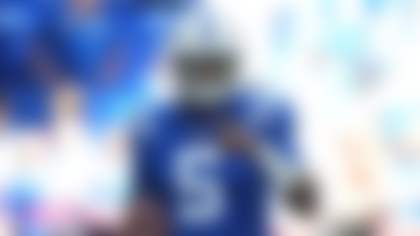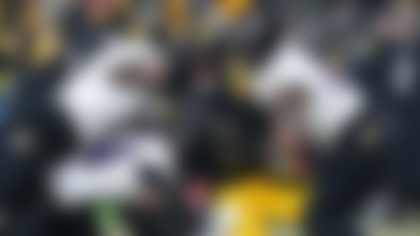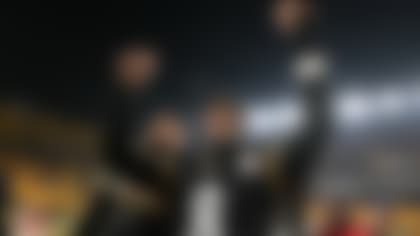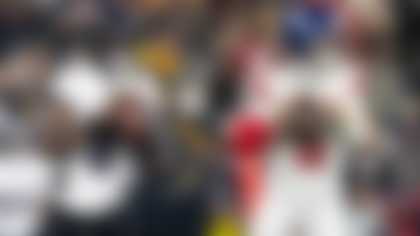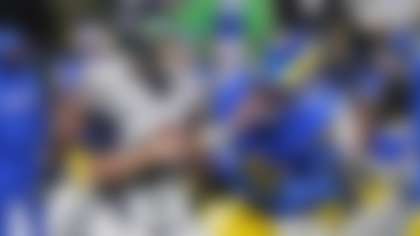Long before the NFL began its annual splashy spectacle of playing regular-season games in London in an effort to forever plant the league's flag in Europe, there was a quiet and all-but-forgotten little trip to Tokyo made by the 1976 San Diego Chargers and St. Louis Cardinals -- one that truly kicked off the NFL's international era.
Forty years ago in August, with a notable lack of hype or fanfare, the Chargers and Cardinals met in a Week 3 preseason matchup that marked the first time an NFL game had been played outside of North America. No two NFL teams had ever traveled farther to meet on the football field, and though it was a relatively meaningless exhibition game, the Mainichi Star Bowl -- as it was labeled by its local sponsors -- provided a trove of memories for the men who played in it. Well, maybe not the game itself, which, as a UPI report said, was "a lackluster affair," won by St. Louis, 20-10. But it was certainly true of the trip to Japan, with all its eye-opening cultural discoveries.
From a bout of late-night food poisoning, to the language barrier that briefly stymied efforts to locate some of the Cardinals and Chargers coaches in a stadium box upstairs, to the unusual way the Japanese chose to line their football field -- and let's not forget the memorable shenanigans on those long flights -- the journey that San Diego and St. Louis went on four decades ago makes for a rich, entertaining tale that has been waiting all these years to be told.
So, as we prepare for the NFL's latest international installment (Texans-Raiders in Mexico City on "Monday Night Football"), here is the story of that groundbreaking football trip to Tokyo, told by six of the Cardinals and Chargers players who made the trek and played pioneers of sorts in that long-ago contest. Four of the six are members of the Pro Football Hall of Fame: Dan Dierdorf (Cardinals offensive tackle), Jackie Smith (Cardinals tight end), Roger Wehrli (Cardinals cornerback) and Dan Fouts (Chargers quarterback). St. Louis running back Jim Otis and San Diego tight end Pat Curran also shared their recollections of that historic trip.
Staged at Tokyo's Korakuen Stadium -- home to baseball's Yomiuri Giants until 1988 -- the Cardinals-Chargers game was authorized by the NFL but not put on by the league, as International Series games are today, according to the UPI story. There was no red-carpet treatment for the participating teams, compared to current standards. The Cardinals and Chargers were there because team owners Bill Bidwill (St. Louis) and Gene Klein (San Diego) liked the sound of helping expand the NFL's reach and popularity. Not that the players had exactly the same focus and goals.
Dan Dierdorf, Cardinals offensive tackle: I think everybody felt the standard excitement that comes with going someplace you've never been before. But I suspect if you'd have put that trip to a team vote, I can't imagine anyone that would have voted to go do that in the middle of training camp. To go all that way to play a preseason football game? So it was more of an obligation than anything else.
Jackie Smith, Cardinals tight end: It was a change in the schedule from regular training camp, so that part of it was kind of a novelty thing. Going to a foreign country. I had never been overseas at all. But more than anything, it was kind of a pain in the butt. The plane ride, the whole bit. Coming back, I remember that plane looked like a cargo carrier, we had so damn much stuffed in the back of the thing. It was stacked to the ceiling back there.
I just know I wouldn't want to be doing that trip very often. I don't know what the NFL was expecting to get out of it at the time, and I still don't really know now what the end game was or what the reward would be. Maybe building up a following over there. But they've got a long way to go when it comes to education of the game part for those fans.
Pat Curran, Chargers tight end: I actually found it kind of exciting, but there was some grumbling on the plane for the trip going there, because it was so crowded. Every seat was filled up, and when you sit like that for 13 hours on an airplane ... We were sitting three across, and I'm sitting next to two defensive linemen, some of the bigger guys on the team. It was a crowded, long trip. We should have had a bigger airplane, obviously. But it made it.
Dan Fouts, Chargers quarterback: We stopped in Anchorage (Alaska) to re-fuel, because I think if you look at the curvature of the earth, that was probably the shortest route. It was an adventure, there's no question. We were just ballplayers, and not very smart. We just did what we were told. So we went. The amazing thing was, it wasn't an NFL-organized deal. It was just two teams out of their minds going to Japan to play a preseason game.
The Cardinals' traveling party had an extra four-plus-hour flight from St. Louis, but chose to break it up, landing in San Francisco for the night and actually squeezing in a practice session (this was still training camp, after all) at some site that has been lost to the haze of memory. But the next morning, the team took off on a commercial Japan Airlines flight, mixing right in -- at least, as much as an NFL team with a preseason-sized roster can -- on the 747 with the tourists and business travelers making their way to Tokyo.
Dierdorf: We were in the back of the airplane, back in coach. And about an hour and a half after we took off from the Bay Area, there wasn't a drop of alcohol left on the airplane, except for sake. I had a few teammates who were a little over-served on sake, because I got a tap on the shoulder from our GM, Joe Sullivan, who asked me if I would go retrieve Tom Banks, our center, who was wandering around the airplane up in the front.
I went and found him, and he had to put his hands on my shoulders as we navigated our way back to where we were seated. All I can remember is, back then, the flight attendants wore these little pillbox hats and white gloves, and I think they were a little overwhelmed as to how big we were and how much we drank.
Smith: That's right, Banks got into the sake on the way over there, and he got pretty drunk. And then when we got to the hotel, he had a tough time negotiating the process of getting on and off the hotel elevator. He probably wasn't alone. I had a few of those sakes. I can't remember all the details, but I know there was a lot of it going around.
Jim Otis, Cardinals running back: Yeah, that flight over, it seemed longer than even 13 hours, though. I had my mother and my wife on that trip with me, and we were all seated together. There were some people who really got into the sake pretty good. But I didn't really have anything to drink, because I knew you could really get into trouble on a flight that long.
I had a different sort of problem. We flew through a storm on the way over there and really got tossed around a little bit. I was back in the bathroom, and the door just opened up during this storm, and I had a hard time to get up and shut the door. I remember that distinctly.
Roger Wehrli, Cardinals cornerback: I think we each paid $1,000 so our wives could come along on that trip, and it turned out to be a great trip. That was the other side of the world, about as long a trip as you can take, and I don't think any of us had been there before. But even on the flight, it was a fun atmosphere with the whole team together, taking up a whole section of the plane. Just to have a stoppage of training camp back then was big. It gave us a break, and was really a fun experience for everybody.
Curran: I just remember when we finally got off the plane and had to go through customs, we had a defensive lineman named Louie Kelcher, and Big Louie, as he's going through customs, looks around and says, "Man, there sure are a lot of Japanese people here." And we were all like, "Well, no s---, Louie -- we're in Japan." It was one of those funny moments you just remember. It was great.
For the most part, the players on both teams found Tokyo fascinating. The Cardinals arrived first, getting in on Tuesday for a game that wouldn't be played until the following Monday night. The Chargers didn't make Tokyo until Friday, but then they stayed in town a couple of days after the game before flying on to Hawaii, where they played another preseason game against the 49ers in Honolulu's Aloha Stadium the following Saturday night. (They lost that game, too, 17-16. Ah, those barnstorming '76 Chargers.)
That schedule gave the players some time to get familiar with the city, although St. Louis coach Don Coryell insisted on conducting a full-pads practice each morning, leading up to the game against San Diego. Some players, as it turns out, had more local fun than others -- isn't that right, Mr. Fouts? But we digress.
Fouts: We didn't have a whole lot of organized activities like they would have now for an international game. There were no parades or banquets that I can recall. I just remember hanging out and walking down streets and seeing what we could buy, stuff like that. It was not the red-carpet welcome at all. It seemed we were on our own a lot, and I'm not sure we had a curfew (under Chargers head coach Tommy Prothro).
I know we didn't, because we went out a few nights. Is this story X-rated? I probably can't talk about all the massage houses we went to. We'll leave that out of the story. But yeah, there were a few times when the nightlife was enjoyable. I was 25 and unmarried. It was very educational, to see a different culture.
Dierdorf: We had curfews, I'm sure of it. And I'll tell you what we did -- we practiced every day. And we had to dress in our hotel rooms and then get on a bus in our uniforms. So imagine what we looked like to the Japanese as we were walking through the lobby of our hotel in our uniforms. It was training camp. These weren't walk-throughs. We were in full pads. They didn't know what to think of us.
Wehrli: One night, (return man) Gary Hammond and his wife, and my wife, Gayle, and I went out and decided to walk some streets and go to a local restaurant. We ended up getting some food -- and this isn't a real pleasant story -- but we didn't have any idea what it was. Late that night, we're back at the hotel, sitting around in the hallways talking, and all of a sudden, Gary and his wife and I just kind of looked at each other, and we all got up about the same time and headed straight to our rooms. That food went right through us, and I don't even remember what it was. It was kind of like radishes, and it smelled terrible.
Curran: It was really neat walking around Tokyo. I remember maybe three of us with our wives walked into some type of bar one night. And if you wanted a drink, you had to buy the whole bottle up front. And it wasn't cheap, as I recall. So we buy the bottle, and each of us had one drink out of it, and then they take it and put your name on it and put it on a shelf. That bottle is probably still there. It was Suntory whiskey or something.
Dierdorf: I know we all bought a bunch of electronics and took them back home, because they were duty free. So we got out some. The other visual I remember was walking down the Ginza (district), and because I was so much taller than most Japanese, I could walk down a sidewalk packed with people, and I could see for a half-mile ahead of me. It was a complete, unobstructed view.
Wehrli: We took a train one day to visit a shrine up in the mountains outside of Tokyo, and then we got on a bus and went up this mountain road with switchbacks. And the bus driver was going fast, and every time he would take one of those hairpin turns, everybody would start going, "Woah," just kind of yelling. And the driver would look back, and he'd smile, and keep going faster and faster. He thought we liked it and were having fun, and the faster he went, he didn't realize we were saying, "Stop!!" Finally, somebody interpreted to him that we were scared to death, rather than wanting him to go faster.
On that same trip, some of us were wearing shirts with the Cardinals emblem on it. We started talking to this one Japanese guy, and he wanted to know what it was. We were trying to explain to him when he looked at it and finally said, "Oh, oh, woodpecker. Woodpecker." We were all laughing, but Mr. Bidwill was sitting two rows back and he didn't really laugh at it much.
Even the actual football portion of the trip brought with it plenty of moments that felt completely foreign to the players. Like the Cardinals walking through the stands of Korakuen Stadium each morning to go to practice, being overwhelmed by the smell of the fish that had been consumed at the previous night's Yomiuri Giants baseball game. Or trying to make sense of what the Japanese used to line the field on game day, or what their fans were chanting during the game. Even the curious way the locker rooms were laid out. They certainly weren't in Kansas anymore.
Smith: They played baseball at that stadium, and walking through there to practice, I had never seen so much garbage in the stands in my life. I think everybody comes to the stadium to eat. There was food all over everything, and food containers everywhere in the stands. How they got the damn thing cleaned, I have no idea.
Fouts: They didn't line the field with paint or chalk, they lined it with, like, a bread-dough substance. All I know is, when it started to rain, whatever they were using started to rise. I mean, it was funny.
Curran: I remember catching a swing pass from Fouts and getting tackled, and I wiped out about 5 yards of the sideline. It just disappeared. I was like, what the heck is this? It was amazing.
Otis: It was more like some sort of soap or foam they used to line the field. And when we got sprinkles during the game, it started to run in the rain and move out of its parameters, from where it was supposed to be marking. They did the best they could, I guess, but they'd never seen a football game over there before.
Curran: The locker rooms slanted down, because you walked in and it was like a 7-foot ceiling, but it went down to like a 4-foot ceiling toward the middle. We had to put the bigger guys up front and then the smaller guys toward the back, and they even had to hunch over to get into their locker. They build the locker room underneath the damn stadium seats. Then there was a 2-foot trench in the middle of the locker room, and that is where we went to the bathroom, right there in the open. It was like, "Wow, these people are different."
Fouts: We stayed at the Grand Palace Hotel. So every time we went to get a cab home, we had to show the driver our hotel keys to show them where to take us. Then they'd drive us right to the Grand Palace.
Dierdorf: Same thing for us. We were at the New Otani Hotel, and they taught us to take a pack of matches from our hotel to show the cab driver where to take us when we were ready to go back. That always worked.
Curran: I remember walking out on the field before the game, and our club executives were pointing up to the boxes where our coaches were supposed to sit. And they kept saying, "We'll put our coaches up there." But the Japanese were thinking they were going to have to somehow lift the buses up that high, because they called buses coaches. They kept trying to ask, how were they supposed to put those buses up that high? It was a communication breakdown, but finally we got them to understand we were talking about men, people.
Played in a slight drizzle, the game unfolded without much drama. According to UPI, about 40,000 fans attended in a stadium built for 50,000, and there was a steady cacophony of noise throughout, usually unrelated to the typical flow of crowd noise at a football game. The Cardinals took a 10-3 first-half lead, then the Chargers stormed back to tie it 10-10 in the third quarter on a Fouts touchdown pass. Finally, St. Louis reasserted control and won, 20-10. The fans seemed to enjoy the festivities, taking turns shouting either, "Chargers, Chargers, banzai! Banzai!" or "Cardinals, attack the ball!" according to UPI.
Dierdorf: The people who were at the game watching had no idea whatsoever what was going or what we were doing. They didn't know when to applaud or cheer. It was kind of strange and different from any other game I had ever played in.
Otis: They tried, and we even had (Cardinals) cheerleaders over there. But they didn't know when to get up and scream and yell. They knew that's what Americans did, though, so they tried their best to do it. But they didn't know anything about football, and I don't know that they do today.
Smith: We got a kick out of the way they'd all get together and figure out somebody's name, and then start trying to pronounce it and cheer for that name. They cheered the entire time, even though they had no idea what they were looking at, which was interesting. I heard nothing that made sense, until they started chanting my name. But it came out "Jackie Smitz, Jackie Smitz." They'd always say both names.
Fouts: They cheered whenever they saw the ball in the air, whether it was a punt, pass or kickoff. They'd go, "Hooo!" or "Banzai!" ...
All I know is that we traveled halfway around the world to lose a couple games. I actually separated my sternum in the game. I fell on a fumble and a guy fell on top of me, and so after the game, I was hurting pretty good for a while. I missed the next game in Hawaii.
The flight back was even worse, because we had eight hours to Hawaii, and it was like still the day before when we got there, something stupid like that. And we got off the plane and we actually practiced. So we practiced before we left Tokyo, and then we got off the plane and we practiced again in Honolulu.
The Cardinals flew home to St. Louis the next morning and, remarkably enough, played and won in Chicago just five days after the game in Tokyo. The Chargers lingered for a couple of days, then headed for Hawaii and their date with the 49ers. St. Louis, the two-time defending NFC East champion, went 10-4 that season under Coryell but missed the playoffs due to a tiebreaker. Ironically, a month into the 1978 season, Coryell was named the Chargers' head coach, replacing Prothro. He went on to build one of the NFL's great offensive juggernauts and take San Diego to two consecutive AFC title games in 1980 and '81. In 1976, San Diego started 3-0 in the regular season but finished 6-8 -- which was still a four-win improvement over its dreary 1975 campaign. One highlight for the Chargers in that '76 season: Bill Walsh was on staff as an offensive assistant under Prothro.
The NFL would not stage another international game until 1978, in Mexico City, and then made its first appearance in London in 1983, when the St. Louis Cardinals lost to Minnesota at Wembley Stadium. Dierdorf was on that trip, too, in his final NFL season. The league finally got back to Tokyo in 1989, where it played nearly annual games through 2005. But there can be only one first-time pioneer, and the Cardinals and Chargers earned that distinction with their long sojourn in August 1976.
Curran: I remember leaving Tokyo and us saying, "Well, we must have started something, because I bet you this will be carried on from here, because it was so well-received." It was an exciting time, especially for us, because we were the Chargers and we didn't have a powerhouse team at the time.
Otis: It wasn't a vacation for us, but I enjoyed it. I really did. I'm glad if we had to travel that far, we at least did something good and won. The football game was really an afterthought, though. I was more excited about being able to go over to Japan. We were guys in our 20s, and it was a big thing for us to get over there. But we didn't look at it like we were making history.
Smith: It was just an adventure. It was nice to say you went over there and played the game and saw that part of the world. But to be honest, the most dramatic part of the thing was the long-ass ride back and forth.
Fouts: Let's face it: Really, we should all be in the Japanese Pro Football Hall of Fame. Both teams!
Follow Don Banks on Twitter @DonBanks.

